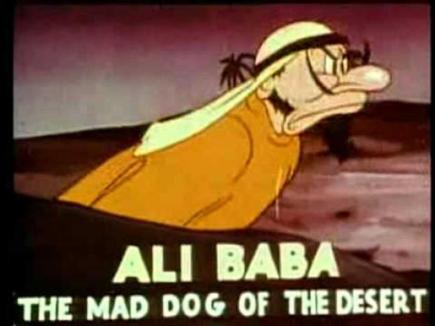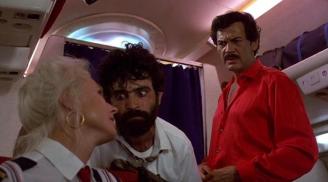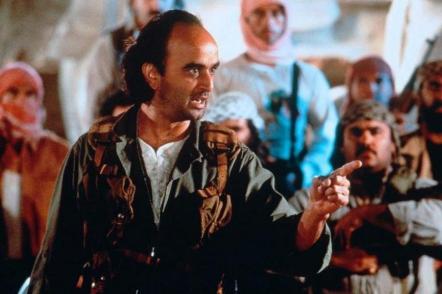#Culture
The Creation Of The Stereotypical Arab
Published
By
Omar Sayadi
Robert Entman, professor of media and public affairs, published an excellent study in 1993 in which he explained the inner workings of framing. Framing is a well-known concept within communication sciences and the study of mass communication, and concerns according to Entman both selection and promotion. He describes it as:
“The selection of some aspects of a perceived reality to make them more salient in a communicating text, in such a way as to promote a particular problem definition, causal interpretation, moral evaluation and/or treatment recommendation for the item described”. (Entman 1993)
A typical frame consists therefore of four qualities. It selects a specific problem by considering and checking the related actors, with which resources they act and observed from their own cultural framework. Then, the greater forces behind the problem are identified, i.e. the broader context. Subsequently, ethical questions are raised that interpret and evaluate the effects and actions of what is taking place. Eventually, solutions and treatments are offered.
Entman illustrates this by giving the example of the Cold War. According to him, American media made during that time frame extensive use of the so-called “Cold War frame”. This frame selected for example the Vietnamese Civil War as a specific problem. It then identified the actors and greater forces behind that war, usually Communist rebels supported by the Soviet-Union and China. Subsequently, these media ethically appraised the whole situation, interpreting the war as instances of severe Atheist agression. This frame could then eventually lead to the promotion of specific solutions being presented to the common man, among which support of the United Stated to the opponents of Communism, and military intervention.

Keep supporting MuslimMatters for the sake of Allah
Alhamdulillah, we're at over 850 supporters. Help us get to 900 supporters this month. All it takes is a small gift from a reader like you to keep us going, for just $2 / month.
The Prophet (SAW) has taught us the best of deeds are those that done consistently, even if they are small. Click here to support MuslimMatters with a monthly donation of $2 per month. Set it and collect blessings from Allah (swt) for the khayr you're supporting without thinking about it.
Framing is a means used by mass media to transmit specific messages to the audience. This is accomplished by using the classic transmission model, i.e. the sender who sends a message to the receiver through a channel/medium. However, Entman adds culture as an additional element for the transmission of a frame. Professor mass communication, writer and expert on racial and ethnical stereotypes in the media, Jack Shaheen, expands on this theory. After all, the framing phenomenon can not be completely understood when detached from the social and cultural context in which the message is transmitted to the audience. The era of Communism and the “Cold War frame” may be over, traditional mass media keep using frames to promote specific images among their audience.
Images that would certainly have a hard time to take root where it not for it adaption to existing and established cultural convictions. Convictions that were built up and developed through decades-long illustrations and representations within cultural productions, most notably in the movie industry.
Hollywood
Shaheen did some extensive research on the cultural depiction of Arabs in the Hollywood society. The results of his observations were brought together in the documentary Reel Bad Arabs (2006), one I’d recommend everyone interested in this subject. “Arabs are the most malign group in the history of Hollywood. They’re portrayed basically as sub-humans,” says Jack Shaheen to open his argument. “These images have been with us for more than a century.”
During no less than thirty years he watched thousands of movies, from the oldest ones to modern blockbusters, to observe and analyse the depiction of Arabs en Muslims in Western cinema. He subsequently discerns a dangerous and systematic pattern of hateful and racist stereotypes that strip a whole people of its humanity and depicts them as the embodiment of evil, fanaticism, and ignorance. According to Shaheen, this is an established fact from which filmmakers rarely deviate.
The land of the Arabs! An image Hollywood eagerly adopted from long-lost British and French explorers and writers that depicted the Arabs based on their own biased imagination of the Orient, the strange and exotic land that seemingly emanated stories like “One Thousand and One Nights”. The land with its eternal deserts, its threatening roughness, and ominous music. The desolate wilderness littered with palaces of rich and decadent pashas and their harem. The mysterious melodies that guide the movements of voluptuous belly dancers and snake charmers, watched by the all-seeing eyes of the scimitar wearing guards in movies like Invitation to the Dance from 1956.
Even today, such stereotypes are being used, even in children’s movies. Disney’s Alladin (1992) has been watched by millions of children all over the world but recycles nearly every stereotype that had been already used by the silent black-and-white Hollywood past to depict the so-called Arabland. A rough, unfriendly desert landscape where “they cut off your ear when they don’t like your face”, as stated in the opening song of the movie.
In the Looney Tunes animated cartoon Ali-Baba Bound (1940), we see the fairy tale character depicted as a cunning, insidiously grinning Arab with a beard, big nose and evil eye-brows who calls his companions by literally barking at them like a dog. The caption of the show reads: “Ali Baba, the mad dog of the desert.“
Not only children, but adults as well see Arabs depicted in movies as hot-headed and impulsive simpletons who deliver some cheap and funny laughs. Take for example the India Jones movie Raiders of the Lost Ark (1981), in which Indiana ends up face-to-face with a threatening and completely random armed Arab. The man tries to impress the American hero with his evil smile and some sword tricks, to which Indiana simply shoots him dead and runs off to continue his adventure.
The same Arab that prefers dogs over women. Indeed, an Arab states in The Happy Hooker goes to Washington from 1977 that “dogs are better than sheep. They’re cleaner, I know, I’ve tried dogs.” And if it isn’t dogs or sheep (think of the popular nickname “goatf*#ker” used by Dutch filmmaker Theo van Gogh to publicly denote Moroccans), than it is blond, American women.
The stereotype of the obtrusive Arab obsessed with white women appears so many times that it becomes ridiculous.Click To Tweet
In the Bond movie Never Say Never Again (1983), Kim Bassinger is being undressed by a filthy Arab businessman to be sold, with an unintelligible gurgling and crackling (Hollywood Arabic), to a bunch of miserable Bedouins. Arabs are being depicted as primitive and aggressive desert dwellers obsessed with American women as a welcome change to their usual covered and invisible womenfolk hidden in their palaces.
Those Arabs, on the other hand, that do effectively have access to modern society, technology and progress are being imagined as a faceless nuisance to Western society or death and destruction craving terrorists anxious to ruin the West.
Two businessmen in The Bonfire of the Vanities (1990) jokingly state that Arabs “don’t go anywhere without their animals.” Note that they were talking about a recent trip by plane!
“How was London?” the main character of the movie Chapter Two (1979) is being asked. “Full of Arabs,” he replies. Movies that are in no way related to Arabs or Muslims and aren’t connected to the Middle-East in any way still can’t resist to the urge of making racist and humiliating comments on screen.
Back To The Future
Even in the hugely popular Back to the Future from 1985, the above statement is sadly the case. The movie is a plain, American Sci-Fi picture for teenagers in which stereotypes about Arabs are nevertheless again introduced. Emmett Brown, scientist and the inventor of the time-traveling car is minding his own business when he suddenly gets shot at, without any motive or reason, by a bunch of Libyan terrorists. They shoot him and then focus on the main character Marty McFly. The shooter curses violently when his weapon jams and fails to kill McFly. When he finally resolves the issue with his machine gun, their car breaks down so they again fail in an almost cartoonish way to continue.
The reason for this sudden and random occurrence is completely unknown, and all throughout the rest of the story no reference is made to it. But the fact remains established, a group of inept Arabs killed the beloved professor.
Foreign Policy
Just like the above-mentioned Cold War frame, this frame on Arabs and Muslims is a perfectly suited tool of the mass media and the political establishment to help shape American foreign policy in the Middle-East and North Africa in the minds of the American citizens. Four different events caused Hollywood to radically increase its use of Arab and Muslim stereotypes. Before anything else, the creation and establishment of Israel in 1948 en the subsequent Arab-Israeli wars resulted in a clear positioning of the United States and Hollywood on the side of their Israeli ally. The Arab embargo that hit Europe and the USA during the 1970’s and the Iranian Revolution further contributed to the role of Arabs as thugs and greedy businessmen. The notorious War on Terror could count as the fourth reason for the establishment and representation of the Arab and Muslim as enemy of progress and freedom.
Take for example the plans of a rich Arab oil sheikh to buy his way up through the United States, conquering it in the process. In the movie Network from 1976, it’s insinuated that a group of Arab businessmen threat to almost run over the Unites States financially by buying up several companies and building plots. The character of Howard Beal than calls live on television to rise against these Arabs, that are planning to buy his TV network. A memorable and frightening scene than follows in which the audience can see a mob of angry citizens take to the streets to express their rage, an image of social hatred against a common enemy, the Arab.
The Ultimate Demon
If it’s not an evil, perverse, and decadent Arab businessman, the Arab gets the role of dangerous and hostile terrorist assigned. Reserved for Russians and Cubans during the days of the Cold War, Palestinians would later figure as the antagonists of the hero in American action movies. The terrorist antagonist stripped from any bit of motive and humanity, serving as fleshly embodiment of the ultimate evil.
This image is already used as early as 1960 in the movie Exodus, where the Palestinians are depicted as invisible enemies hiding in the desert who perform appalling acts against the innocent Jewish colonists because of their radical antisemitism. It’s no wonder that this movie was considered a major promotion for Zionist thought and a support for the Israeli cause.
Theologian and writer Roland Boer writes in his 2009 work on Biblical themes that the depiction of the Palestinian-Israeli conflict in American cinema still influences American citizens to this day with regard to their opinion on the conflict.

Over a decade later, we find the same old story in the movie Black Sunday (1977). A Palestinian female terrorist wished to detonate a blimp over a typical American sports stadium during the Super Bowl, with about 80.000 ordinary Americans present. The caption of the movie on its release poster reads: “It could be tomorrow!” Again, a decade later, Arnold Schwarzenegger faces a group of Palestinian terrorists that wishes to destroy American cities with nuclear missiles in True Lies from 1994. Again and again, Arabs and Muslims are being identified with hatred, terror and the ultimate failure of their plans due to the American action hero.
An image that, not unimportantly, was fed extensively by two Israeli producers, Menahem Golan and Yoram Globus, who created The Cannon Group company. For over twenty years, The Cannon Group produced at least thirty movies in which everything Arab is being mocked and demonized. Yes, the political relationship between the USA and Israel does indeed trickle in the world of cinema. What could be a more effective weapon than a seemingly unending source of full-length movies in which enmity and distrust against a certain people is promoted? A cultural alliance to dismiss these Arabs, “sand n#^*rs”, “goat f*^#rs” and “ragheads”, fed by a billion dollar business.
The most striking example of this would be the movie Rules of Engagement from 2000. The film leads the audience to Yemen, where a mob of dusty Yemenis are protesting loudly in front of the American embassy. American marines are being asked to evacuate the present staff, when they suddenly open fire and mow down every single protester, including women and children. As a result of this event, an investigation is started to examine the decision of the marines to open fire. Towards the end of the movie, however, the audience is revealed a whole other story than initially portrayed. Plot twist, the Arab protesters were armed themselves and they opened fire on the American soldiers.

Men and woman wildly brandishing guns and even a little girl that aims her pistol on an American soldier. A little, Arab girl that wasn’t nearly as innocent as she looked. A whole bunch of Arabs that weren’t as innocent as initially thought. They deserved to die! It was their own fault they attacked the mighty American army of the free! The marines had the right to kill them, to protect themselves! Sure, it was a massacre, but a legitimate one against the enemies of the USA. Against faceless, unknown human beings killed like animals.
Debunking Cultural Practices
Such movies present complicated and nuanced conflicts as a caricatural fight between Good and Evil. They polarize the wars in the Middle-East and North Africa by presenting the American cause as the necessary and just fight against demonized and inhuman enemy, an intrinsic evil. A propaganda weapon arises on a massive scale because of popular cultural injections.
Entman also describes culture as the “stock of commonly invoked frames“. In fact, he defines culture as “the empirically demonstrable set of common frames exhibited in the discourse and thinking of most people in a social grouping.” The fact that framing is then used extensively in the mass media, which includes movies, soaps and news reporting, could be explained from this point of view.
Because of the prolonged cultural impact of Hollywood, the frame of the Arab and Muslim is undoubtedly established within those societies that lie within its sphere of influence. The frame is developed as a cultural element within that society and determines how people look at messages and images that fit within that frame. The Arab that appears in the news is usually no individual. He’s a terrorist, a religious extremist, a zealot, a Muslim, a Palestinian, Iraqi, Lebanese, Syrian or Iranian. These are all frames that evoke certain connotations among the traditional receiving audience, developed within a shared consciousness.
It’s a dangerous trend, but the best solution is the simplest one of all: look beyond the message alone. Don’t let popular culture or traditional news reporting decide how you see the world, because there’ll always be agendas being followed to guide and manipulate you. Common sense, an open mind, and sufficient dialogue can debunk the most stubborn cultural prejudices.
Keep supporting MuslimMatters for the sake of Allah
Alhamdulillah, we're at over 850 supporters. Help us get to 900 supporters this month. All it takes is a small gift from a reader like you to keep us going, for just $2 / month.
The Prophet (SAW) has taught us the best of deeds are those that done consistently, even if they are small. Click here to support MuslimMatters with a monthly donation of $2 per month. Set it and collect blessings from Allah (swt) for the khayr you're supporting without thinking about it.
Omer Sayadi (*1993) is a former student of the Catholic University of Leuven with a special love for the Middle East and North Africa. After receiving his Master's degree in Arabic Language and Islamic Studies, he worked with both refugees from the region as well as Arabic-speaking foreigners seeking to learn the Dutch language. He writes columns on Islam in Europe, migration and the depiction of Muslims in mainstream media. He started MENA symbolism as a means of combining everything history, politics, symbolism and society in one place.


From The Prophets To Karbala: The Timeless Lessons Of Ashura For Muslims Today

Moonshot [Part 11] – The Fig Factory

Nationalism And Its Kurdish Discontents [Part II of II]: Kurds And Turkiye After Ottoman Rule

Nationalism And Its Kurdish Discontents [Part I of II]: Kurds In An Ottoman Dusk

Moonshot [Part 10] – The Marco Polo

Moonshot [Part 11] – The Fig Factory

Moonshot [Part 10] – The Marco Polo

Moonshot [Part 9] – A Religion For Real Life

Moonshot [Part 8] – The Namer’s House

[Podcast] A Riba-Free Future With A Continuous Charity | Faizan Syed

[Dhul Hijjah Series] Calling Upon the Divine: The Art of Du’a (Part 1)

IOK Ramadan 2025: Four Steps | Sh Zaid Khan

IOK Ramadan 2025: Do Your Best | Sh Zaid Khan

IOK Ramadan 2025: Giving Preference to Others | Sh Zaid Khan





Ah N
March 7, 2020 at 6:41 PM
Very interesting article, there is a no doubt the perception of people is shaped through media exposure and common stereotypes become engrained in their consciousness.
Only thing I would add is it would be useful to add more contemporary examples from the late 00’s and the 2010’s,as this trend of negative potryal has continued.